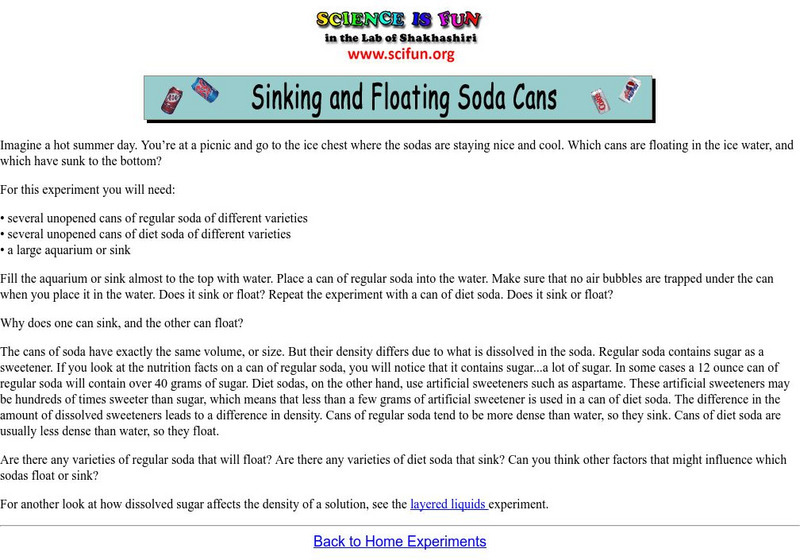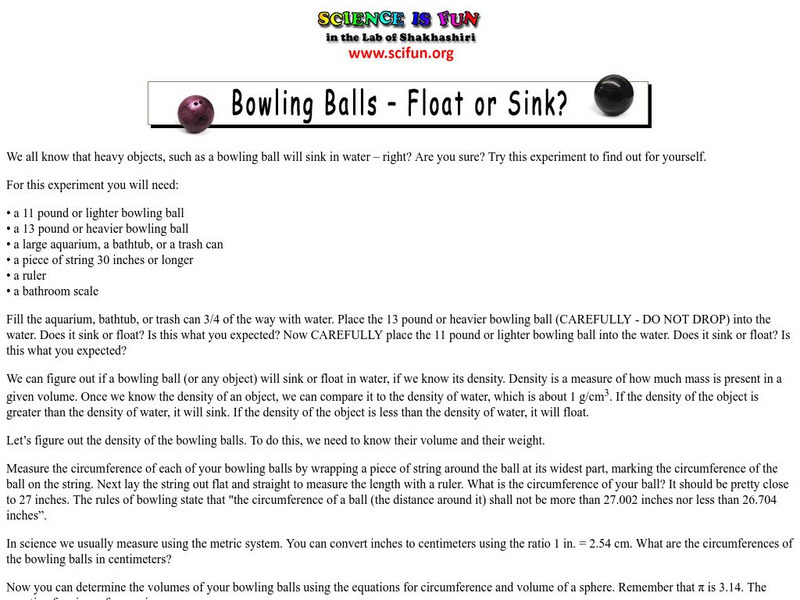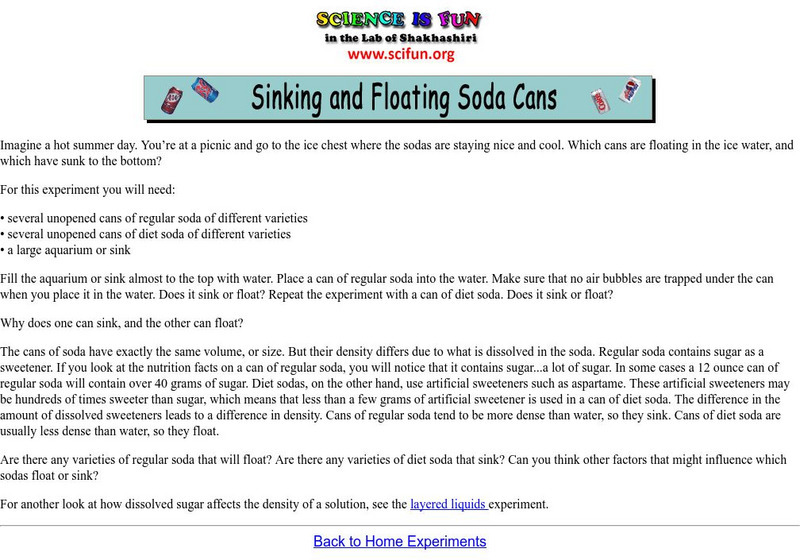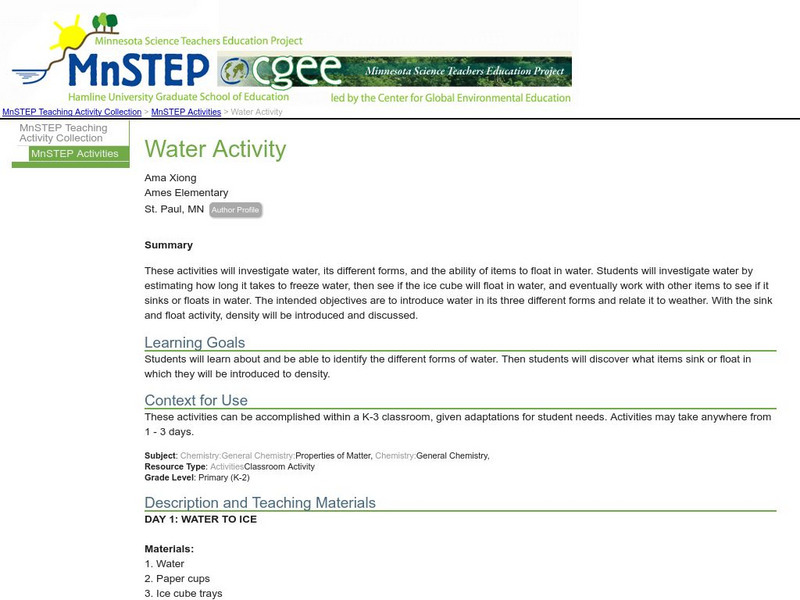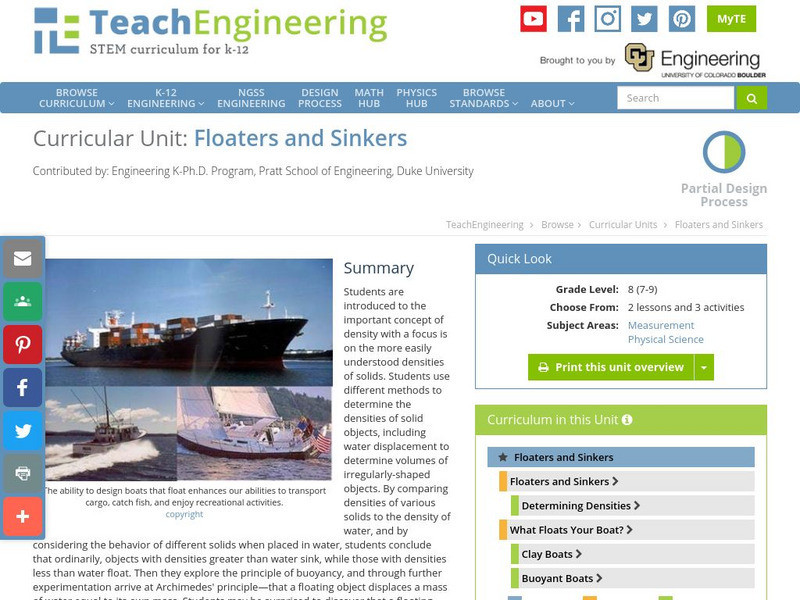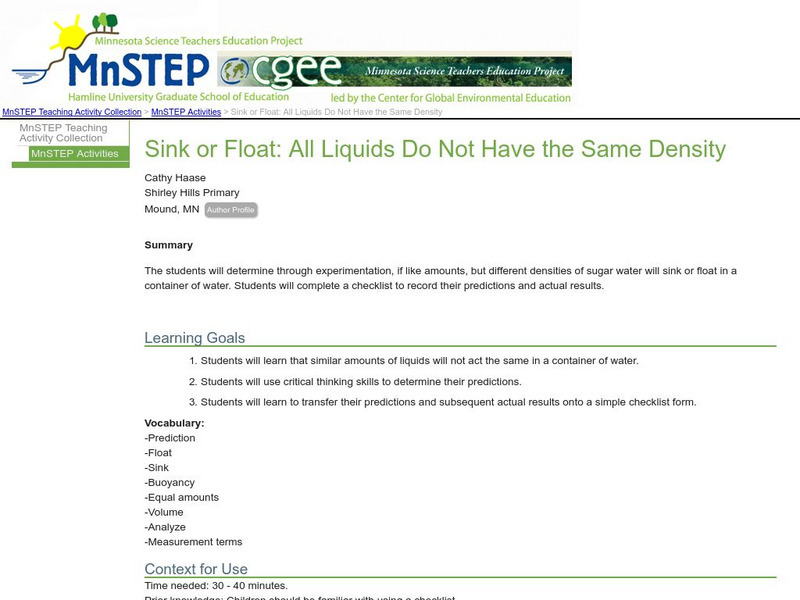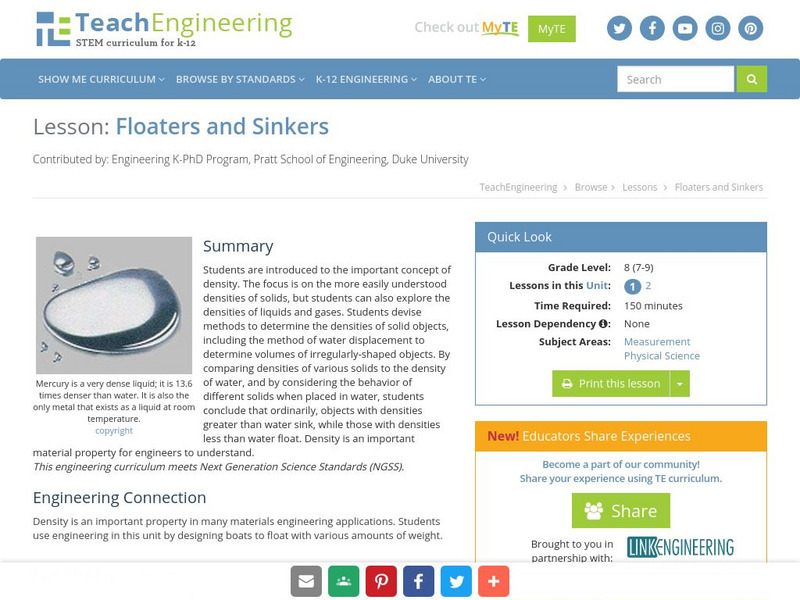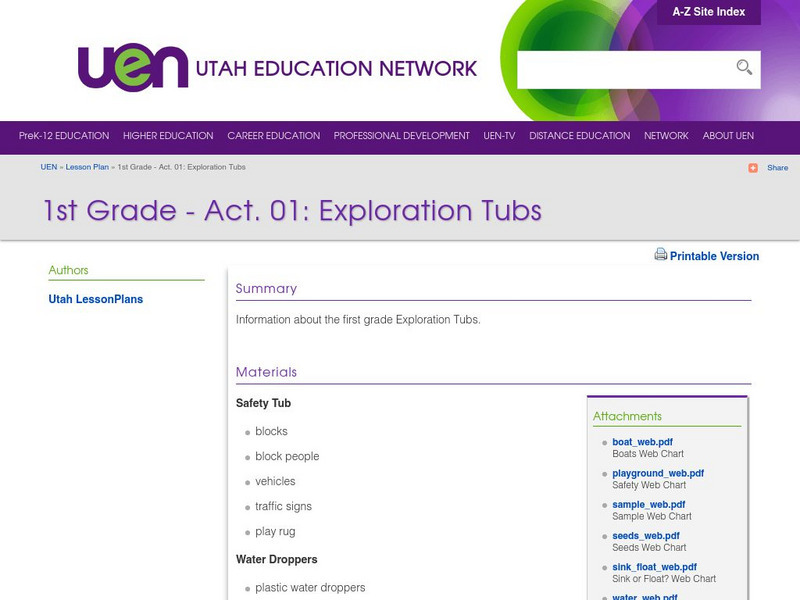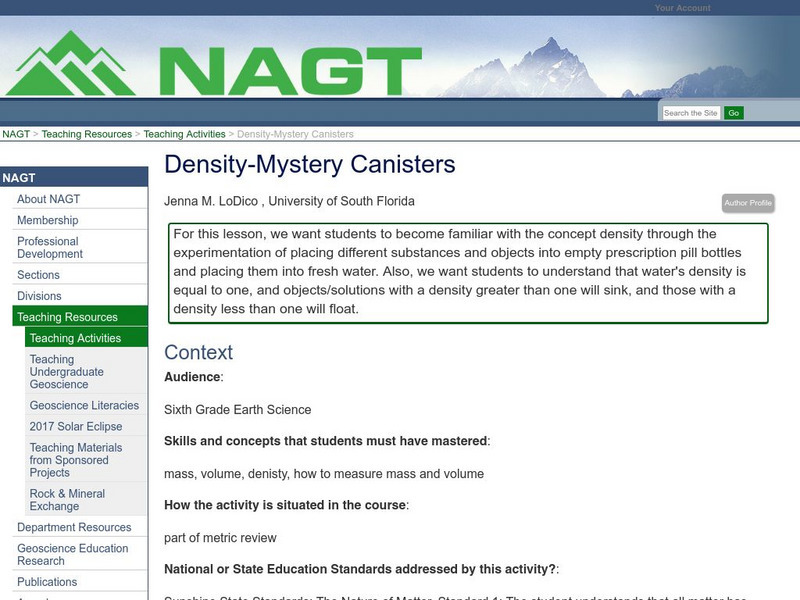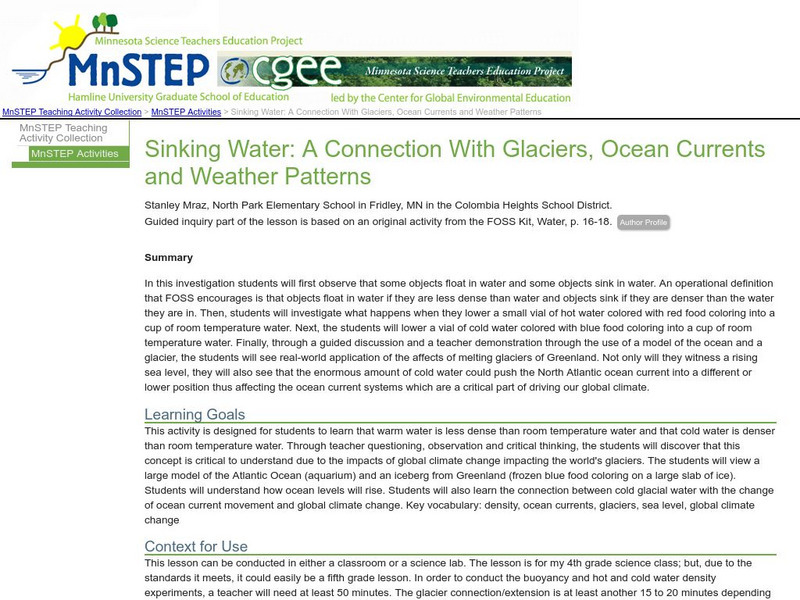Hi, what do you want to do?
American Chemical Society
Middle School Chemistry: Density: Sink and Float for Liquids
Students determine whether a liquid will sink or float in water by comparing its density to the density of water.
American Chemical Society
Middle School Chemistry: Density: Sink and Float for Solids
Learners determine whether an object will sink or float by comparing its density to the density of water.
Science Education Resource Center at Carleton College
Serc: Mn Step: Sinking and Floating Water
An experiment in density where colored water, both hot and cold, are poured into containers of water at room temperature. Students will observe that the warm water rises and the cold water sinks due to their different densities.
American Chemical Society
Middle School Chemistry: Density Sink and Float for Liquids
See how different liquids can have different densities depending on their molecular make-up.
Science is Fun
Science Is Fun: Sinking and Floating Soda Cans
An experiment to determine if either a regular or a diet can of soda will float or sink when placed in water, and what causes this.
Science Education Resource Center at Carleton College
Serc: Investigating Density in Solutions: How Can You Make an Egg Float?
In this activity, students will learn about density by determining how to make an egg float in water. By the end of the activity, students will understand that density and weight are different and that density matters in floatation. They...
Science is Fun
Fun Science: Bowling Balls: Sink or Float?
For a dramatic illustration of density check out this demonstration. It's simple to do, only requiring a bowling ball and some water.
Utah Education Network
Uen: 1st Grade Act. 24: Interactive Writing
In this lesson, students will listen to nonfiction books about items that sink and float. Students will participate in filling in words to fill in a teacher-created chart that is connected to the information. Students will then write a...
Science is Fun
Fun Science: Sinking and Floating Soda Cans
Why do some pop cans float in water while others don't? This easy experiment is a great example of the principle of density.
Science Buddies
Science Buddies: How Much Weight Can Your Boat Float?
Have you ever wondered how a ship made of steel can float? In this project you'll investigate how much weight boat hulls of various shapes and sizes can support without sinking.
American Chemical Society
Inquiry in Action: Changing the Density of a Liquid: Heating and Cooling
In this activity, students will investigate whether the temperature of water affects its density. Students will place colored hot and cold water in a cup of room-temperature water to see that cold water sinks while hot water floats. Then...
Science Education Resource Center at Carleton College
Serc: Water Activity
Students investigate water by estimating how long it takes to freeze, then see if the ice cube will float in water, and eventually work with other items to see if they sink or float in water.
TeachEngineering
Teach Engineering: What Floats Your Boat?
Students use modeling clay, a material that is denser than water and thus ordinarily sinks in water, to discover the principle of buoyancy. They begin by designing and building boats out of clay that will float in water, and then refine...
TeachEngineering
Teach Engineering: Floaters and Sinkers
Through this curricular unit, students are introduced to the important concept of density. The focus is on the more easily understood densities of solids, but students may also explore the densities of liquids and gases. Students devise...
American Chemical Society
Inquiry in Action: Compare the Density of an Object to the Density of Water
In this activity, students use tea light candle holders and a student-made balance to compare the weight of equal volumes of wax, water, and clay. Students will discover that since the wax weighs less than an equal volume of water, it is...
Science Education Resource Center at Carleton College
Serc: Mn Step: Sink or Float: All Liquids Do Not Have the Same Density
An experiment in density. After a review of floating and sinking of different materials, students test four bottles, all holding four ounces of water, to see if they will float or sink. They each contain a different density of sugar...
Museum of Science
Museum of Science and Industry: Online Science: Design a Submarine
Become an engineer, and design a submarine that moves in the water like a real submarine. Try making it sink, float, and hover in the water.
Alabama Learning Exchange
Alex: Teaching Measurement: Literature and Manipulatives
The tradebook, Who Sank the Boat? by Pamela Allen, is an excellent tool in teaching measurement. Learners will engage in activities involving different types of measurement. In the story, five animal friends decide to take a boat ride....
PBS
Pbs: Sesame Street: Science
A collection of interactives, videos, and documents on a variety science concepts.
TeachEngineering
Teach Engineering: Floaters and Sinkers
This lesson introduces students to the important concept of density. The focus is on the more easily understood densities of solids, but students can also explore the densities of liquids and gases. Students devise methods to determine...
Utah Education Network
Uen: 1st Grade Act. 01: Exploration Tubs
In this lesson, students will investigate different categories related to safety, organisms, sink or float, boats, seeds, and water droppers. Students will use exploration tubs to make observations.
National Association of Geoscience Teachers
Nagt: Density Mystery Canisters
Students experiment with items that sink or float, and learn that water's density is equal to one, and objects/solutions with a density greater than one will sink, and those with a density less than one will float.
Science Education Resource Center at Carleton College
Serc: Mn Step: Sinking Water: Glaciers, Ocean Currents and Weather Patterns
A activity where students learn how warm water is less dense than cold water, and what this means for global climate change as ice from the polar regions melts. Students will do experiments in buoyancy and water density when hot or cold,...







